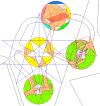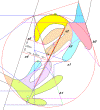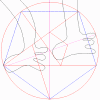|

|
Does the Monkey Star exist outside my imagination?
My hypothesis put the
Monkey Star into its position on the Big X before I knew exactly where it
was going, and what it would do once there. Critics will laugh again in
their certainty that the Ancients had never even thought of these
five-pointed stars, while making the Big X in complete ignorance of the
significance of its 36 degree angle. If that were true, however, then after
the Monkey Star lands by sheer luck on the monkey's body, there should be
very little further orderly correspondence between the two randomly
superimposed figures. Instead, we get the opposite _ a fine attunement
between the the two. |
 |
From head to toe, to tail, the monkey aligns with the star's axes, and other
main gridlines
There is impressive coincidence between the "imaginary" and
the "real". I trust, the reader can see this fact as well as I do.
The monkey also clearly interacts with the Monkey Star's circumcircle
Its
feet are planted on it like on a narrow hoop suspended in midair. The
monkey's upper toes are aligned at 18 degrees to the horizontal. If this
represents a step, steps by both feet should turn the monkey 36 degrees.
These steps are well choreographed for the
Chain of Ten Monkeys - the
ten-fold symmetry of the Big X.
The monkey's head tilts to this circumcircle attentively. it grasps the
circle nimbly between the thumb and index digits of the right hand, thus
simulating the Precision Grip. The monkey could be in control of a gyrating
hoop, or strumming a circular instrument.
Did the Ancients see the Monkey Star just like we do?
Unequivocally, the
answer is Yes. The key to a direct proof of this is already present in the
simple diagram above. It is the Monkey Star's inner circle, one of the
Triplet circles in the
prehistoric Athena engravings. We are about to
witness an unbroken chain of "unlikely coincidences", which will take us to
ingenious rational constructions like a ten-lane autobahn.
The Monkey Star and the Hands
|
Looking at the two in isolation with each other, the order in the diagram
above is nothing short of spectacular. For instance, an observer looking at
the hands directly from the Monkey Star's center actually sees through to
the other side via a dotlike aperture between the fingers. This field, or
cone of vision through the hands dilates to a mere 11- hundredths of a
degree, and thus looks like a normal line.
The fingers are numbered from 1 to 9 (diagram right) |
 |
A line snapped onto the outsides of the Finger-5, and the elbow above is
then perfectly parallel to the vertical axis of the Big X.
Observation: The Monkey's hands help recreate both the horizontal (the right
hand & the tail & the grill), and the vertical axes. This last vertical
frames the monkey from the outside.
Fingertip pairs:
|
Using the same technique of pushing straight lines against the image, so
that these come to rest against two points usually - other main points on
the fingers generate two more X-Star vectors (multiples of 9 degrees): The
vector line touching fingertip 7, and the base of finger 6.
The line resting against the juncture between digits 1 and 2, as well as
against the arc on the left side of finger 7. |
 |
Remarkable, how altogether five of the above mentioned lines create a
special effect, passing through the same tiny central area of the hands.
The Monkey's Head, Hands, and Feet standardize on the Inner Circle of the
X-Star
Line flow on the Monkey falls in two categories:
1) Simple - in which a line progresses steadily in parallel with another
line.
2) Complex - in which the lines flare out and adopt a convoluted form.
|
The head, hands, and feet of the monkey are exclusive members of the complex
category. Of utmost interest is that this entire category is standardized on
the Inner-circle of the X-Star. However, the head does so in its own unique
way (see next diagram). Incredibly, in my CAD drawing of the monkey, the
inner-circle fits the hands and feet to within three millimeters on each
side. Even if such precision is redundant, it showcases the design's uncanny
accuracy.
Why did I undertake to test the X-Star's inner-circle for fit with the
Head-Hands-Feet category? |
 |
I knew it was important to the creators of La Marche. It is one of the
Triplet circles in their concept of the regular 5-pointed star. Thus, once
the X-Stars were set - I just moved this circle around to see what happens,
saw the great fit, and took it from there.
The Foot-circle
The idea of this circle couldn't possibly be simpler - The longest line
across the feet becomes its diameter. This line's length equals pretty well
exactly the diameter of the X-Star's inner circle - 20.08.. X-Star meters.
One of the Monkey Star's arms passes through the Foot-circle's center, the
one parallel to the Big X line 'b'.
The Hand-circle
This X-Star's circle looks quite a bit like a plate balanced on a fingertip.
When checked against the X-Star's major gridlines, the plate's center turns
out smack on the line-b1, running parallel to the Big x-line-b from the
westernmost tip of the X-Star, which we see directly above the Hand-circle.
Another parallel to the Big x-line-b hems in both the Hand-circle, and the
left hand from the south-west. This is line-b2 in the diagram below - and a
tangent to the Hand-circle. The outside of the fifth digit coincides with
"b2" over most of its course. All this must mean that the Monkey is able to
use its hands to convey the Big X line-b, in a clearly spoken body-language.
Hence the vector of "b" seems particularly important. As a matter of fact,
we are able to determine the reason for such emphasis, and it's a very good
reason, indeed. As for devoting some attention to the Big X line-a, the
Hand-circle's center is quite precisely six X-Star meters from it.
The Head-circle
We see the same inner-X-Star-pentagon fit the head, as if by design. Let us
mention that it fits the head this well exclusively in this (X-Star)
orientation.
|
The inside edge of the
5th digit coincides with the side of one of Hand-circle's pentagons
(of the X-star orientation), and so the little finger on the left
hand expresses the angle of 18 degrees, or 1/2 the star's angle at
the tip. The right hand's most remote point from the Hand Circle's
center, connects to it by the line X2 holding accurately the
inclinations of 45 and 9 degrees to the Big x sides. This line is a
parallel shadow of another line which we have observed earlier. We
also come across frequent reminders that we are correct in measuring
the Monkey by the X-star's construction circle unit. |
 |
For instance, the line X4f, drawn perpendicularly
from the Hand Circle's center to the X-Star's side-a, is 6.008 meters long.
For all practical purposes then, this distance is an accurate 6 meters. If
we put another such perpendicular to line-a between the fingertips 1 and 2
(at the same distance from each fingertip), then both these perpendiculars
are separated by the distance of 2.998 meters, IOW - 3 meters exactly. Thus,
we get two lengths in a rather precise ratio of 1/2, or 3/6.
It must be obvious by now that in keeping the X-Star angles, the Monkey's
hands display mastery, which we could earnestly hope to match, only if we
had computer assisted bionic rubber fingers. But, such dexterity of hands
and fingers is normally reserved to humans, or higher primates. Since the
Americas were ever inhabited only by the lower primate species, lacking an
elongated thumb opposable to the other fingers on the same hand, i.e.,
lacking the Precision Grip - then the presence of such features should be
attributed to either anthropomorphism, or the model being a non-American
higher primate. Why is the Nasca Monkey possessed of attributes, which all
real monkeys lack? Mine is the lone voice asking this question, as scholars
normally don't consider the monkey to be anthropomorphic.
We may also choose to view the Monkey's hands as if they were portrayed with
her palms up, or one palm facing up, the other down. These postures look
about equally plausible.
Ultra-Anthropomorphic
|
We may ask about the highly unusual style of the feet, and if it is is
symbolical. For one, the monkey's heel is over-emphasized to the point,
where the leg becomes centered over the foot. Thus, the monkey gains a
trait, which would have it well adapted to a bipedal way of life...
Another ultra-anthropomorphic feature is the beautifully arching instep of
the left foot (the instep tells us, which foot it is), a trait oft regarded
as indispensable to good foot mobility in athletes. |
 |
By the way, the second to fifth human toes are presently atrophying, because
the foot's prehensile capability is not required anymore. Given the
evolutionary trend, is the monkey ahead of humans? This sounds silly on the
surface, but whereas monkey feet aren't all that different from their hands
- such differences are clear in humans and even more pronounced in the
Nasca
Monkey. In principle, the Monkey's foot comes closer to the human norm than
does the human form.
|





